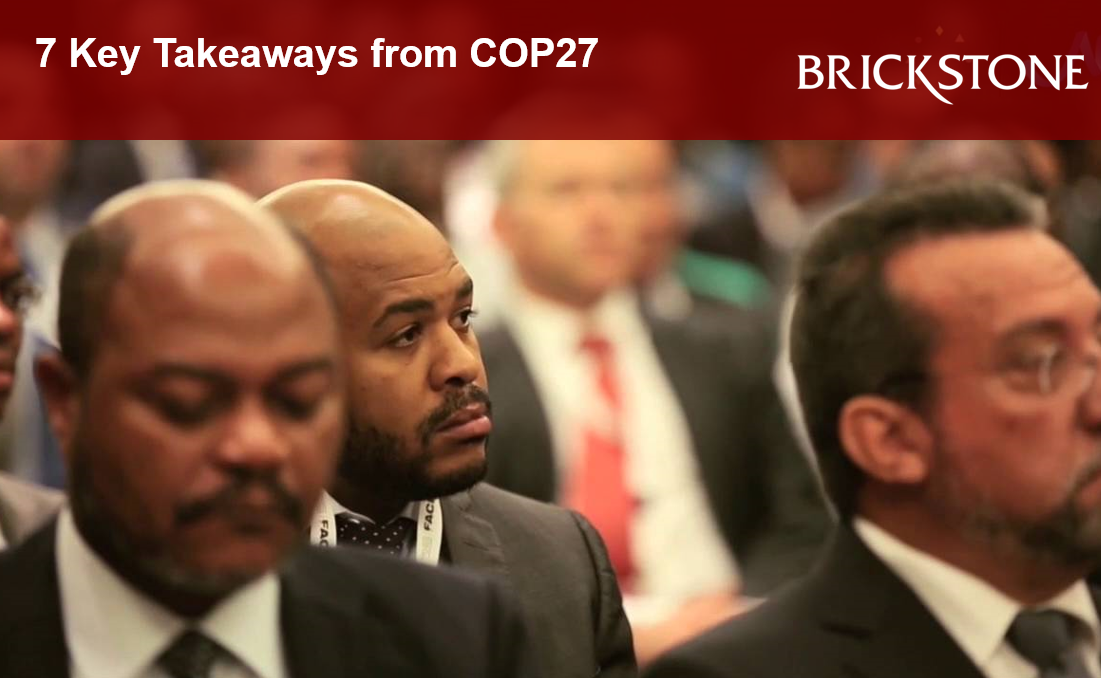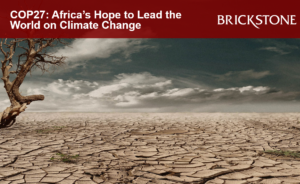7 Key Takeaways from COP27
The 27th Conference of the Parties to the United Nations Framework Convention on Climate Change (COP27), Paris Agreement, was held from 6 to 20 November, 2022, in Sharm El-Sheikh, Egypt. The annual event brought together world leaders, ministers, and negotiators to agree on how to jointly address climate change and its impacts.
Branded as the “implementation COP”, the summit aimed at finally fulfilling previous financial pledges for investing in renewable energy, building infrastructure to withstand extreme weather events, responding to climate disasters, and funding other such aspects of climate action.
This article by Brickstone reviews some institutional reports and publications on the recently concluded COP27, highlighting its key takeaways and outcomes.
The COP27 And Why Is It Important?
Since 2015, under the legally-binding Paris Agreement treaty, almost all countries in the world have committed to keep the rise in global average temperature to ‘well below’ 2°C, and ideally 1.5°C, above pre-industrial levels; strengthen the ability to adapt to climate change and build resilience; align finance flows with ‘a pathway towards low greenhouse gas emissions and climate-resilient development’. The Paris Agreement has a ‘bottom-up’ approach where individual countries decide what action they will take.
The COP27 is important to address climate change together and curb its adverse effects on the world through this international system. The world’s leading scientific authority on climate change, the Intergovernmental Panel on Climate Change (IPCC), states that the world is now in extraordinarily dangerous territory. Every small delay to proportionate action on mitigation and adaptation is a move closer to irredeemable damage to the climate and its ability to meet human needs.
Around half of the world’s population is ‘highly vulnerable’ to the impacts of climate change, with those in highly vulnerable regions already 15 times more likely to die due to floods, droughts, and storms compared to regions with very low vulnerability.
According to Chatham House, COP27 is a rare opportunity for parties and observers to come together and grapple with a challenge that is impacting all of humanity. While the COP takes place in the context of a global ‘polycrisis,’ climate action and cooperation can provide effective ways forward on food, energy, nature, and security, and a vital nexus of international dialogue and cooperation on these issues.
After a marathon weekend of discussions and negotiations, the COP27 climate summit finally ends. Here are 7 key takeaways from COP27:
- Historic ‘Loss and Damage’ Fund: According to the Time, Climate change causes inequities and exacerbates them. The rich countries gained their wealth from fossil fuels, leaving poor countries who haven’t benefited from those emissions with huge bills from the resulting climate impacts. After decades of calls to compensate climate victims in the developing world, COP27 finally produced an agreement to create a fund that would address loss and damage. But this breakthrough comes with enormous question marks. No sums of money were actually committed at Sharm El-Sheikh, and the rules of how the fund would work were left to be decided at next year’s COP28 in the United Arab Emirates. This might be the biggest win in climate since the Paris Agreement at COP 2015.
- Possible Changes Coming to Multilateral Lenders: For the first time, a COP meeting included a call to reform the global financial architecture so that it better aligns with climate goals. The idea is to tweak the mandates of multilateral development banks such as the World Bank and international financial institutions, such as the International Monetary Fund, to ensure that greater financing flows to energy-transition projects and efforts to adapt to a warming planet.
- The Spirit of 1.5C is Strong, even if the Text is Weak: According to the BBC, there’s a fifty-fifty chance over the next five years that we’ll go over this important marker of temperature increases, compared to pre-industrial times. We’re likely to pass it permanently by 2031. But at COP27, the EU and other developed countries were willing to die on the hill of strengthening the promise to keep 1.5C alive. Their efforts were ultimately in vain as the cover text failed to include a reference to the phasing out of all fossil fuels, seen as a necessary advance on last year’s decision to phase down the use of coal.
- The Fossil Fuel Industry Has Finally Come Out Of The Shadows: According to the BBC, one key takeaway from COP27 was the presence and power of fossil fuel – be they delegates or countries. Attendees connected to the oil and gas industry were everywhere. Some 636 were part of country delegations and trade teams. The crammed pavilions felt at times like a fossil fuel trade fair. This influence was clearly reflected in the final text. Demands from India and others for all fossil fuels to be phased down didn’t survive, despite the backing of the EU and many other countries rich and poor. Many African countries were also keen to use the COP as a platform to promote new oil and gas initiatives in their countries.
- The World Bank Reform: According to the Guardian, a growing number of developed and developing countries are calling for urgent changes to the World Bank and other publicly funded finance institutions, which they say have failed to provide the funding needed to help poor countries cut their greenhouse gas emissions and adapt to the impacts of the climate crisis. Reform of the kind widely discussed at Cop27 could involve a recapitalisation of the development banks to allow them to provide far more assistance to the developing world. Nicholas Stern, a climate economist and peer, has calculated the developing world will need $2.4tn (£2tn) a year from 2030. But this is only about 5% more than the investment they would require anyway, much of which would go into high-carbon infrastructure. The World Bank could provide about half of those funds, he estimates.
- Weak Rules For Carbon Markets: Countries agreed at COP26 to create the rules that would allow nations to trade carbon credits. That means that Norway, for example, could pay to preserve Indonesian forests, and in return scrub emissions from the Norwegian carbon ledger. At COP27, negotiators outlined a more detailed framework for how such a carbon market would work, including allowing corporations to buy credits from governments. But experts warned the rules are still not strict enough.
- The Us & China Resume Climate Talks: Aside from the final agreement, the summit, according to Dataphyte, brought several other significant developments including the resumption of formal climate talks between the US and China – the world’s two largest greenhouse gas emitters. After China froze climate negotiations between the two countries this summer, US President Joe Biden and China President Xi Jinping agreed to reestablish US-China communications when they met last week at the G20 summit in Bali, paving the way for Kerry and his Chinese counterpart Xie Zhenhua to meet again formally. “Without China, even if the US is … moving towards a 1.5-degree program, … if we don’t have China, nobody else can make … that goal,” Kerry told CNN last week.
Read more about COP27 here.






